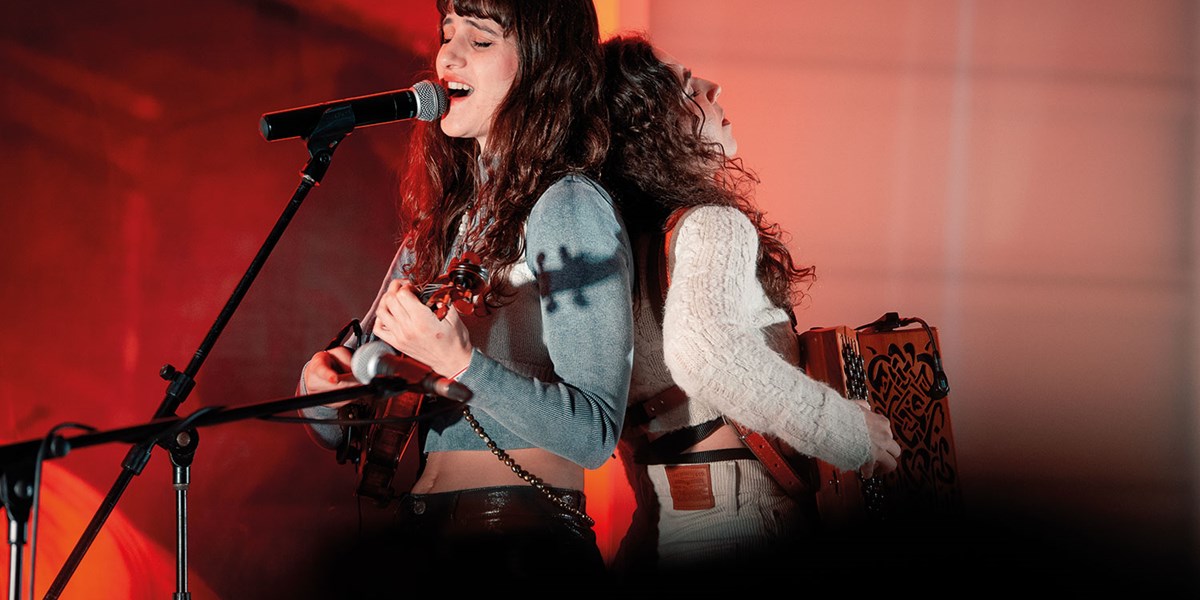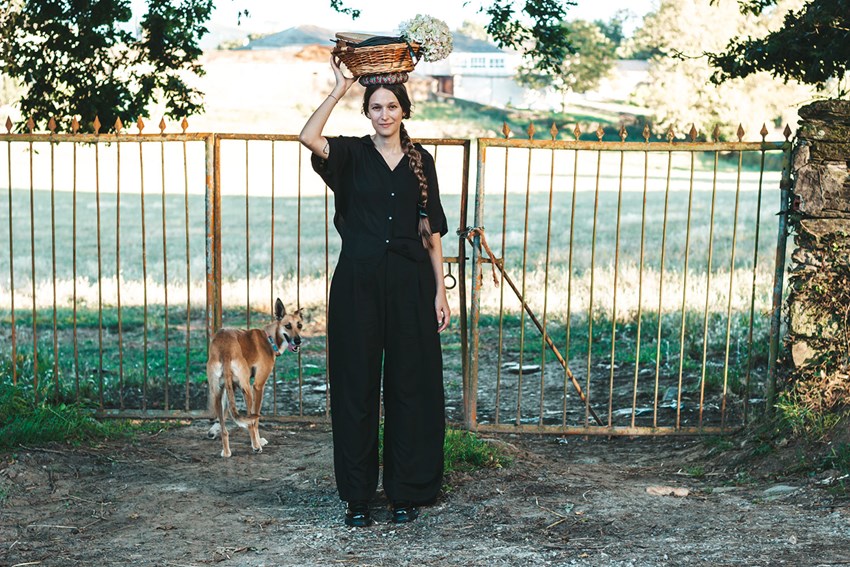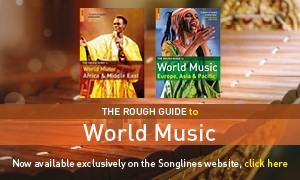Thursday, April 10, 2025
Spain’s folk future: the new wave of artists reimagining tradition for the now
Megan Iacobini de Fazio speaks to a new generation of Spanish artists who are looking at their regional traditions and histories to express contemporary concerns

Caamaño&Ameixeiras performing in Braga for SQUARE (Eva Pombo)
On a chilly January afternoon in Barcelos, northern Portugal, Galician duo Caamaño&Ameixeiras take the stage at the town’s pottery museum as part of the SQUARE festival. Their radiant harmonies and nimble instrumentation fill the intimate space, weaving tales of cursed love and ancient rituals with a warmth that contrasts with the crisp air outside. Around them, an eclectic array of ancient and contemporary pottery figurines, both lifelike and fantastical, reflect the region’s deep ceramics traditions, where centuries-old craftsmanship continues to evolve. More than a collection of artefacts, the museum offers a window into a living tradition – much like the duo’s performance, which breathes new life into age-old melodies, ensuring they remain as vital and dynamic as ever.
Caamaño&Ameixeiras are part of a new wave of Spanish artists delving into regional folk music, not to preserve it in amber, but to interrogate, reinterpret and retain it. Whether through deep archival research, electronic experimentation or theatrical live performances, they prove that heritage lives not in preservation alone but in continuous evolution.
Among this wave are also Anna Ferrer, who draws from Menorca’s oral traditions to craft music that channels the island’s ancestral melodies through intricate vocal layers and minimalist arrangements; Tarta Relena, a Catalonian duo who transform anything from medieval polyphonies to flamenco, Georgian laments and Pashtun poetry into mesmerising vocal explorations; Carmela, aka Carme López, a researcher and teacher of traditional music who digs into the role of women in Galician folk and brings academic rigour to artistic practice; and Rodrigo Cuevas, who reinvents Asturian folk with flamboyant showmanship, sharp humour and a dose of activism.
Folk music is not a fixed genre but an evolving dialogue for these artists. “For me, tradition is not something that is related to the past; it is not a memory of something that was, but rather, it is a set of cultural aspects that constantly changes to adapt to the reality of the moment”, says Carmela, whose debut album Vinde Todas (a Top of the World in SL205) honours the women who keep Galician folklore alive. Luckily, traditional music is still very much part of everyday life in Galicia, and artists such as López, accordion player Sabela Caamaño and violinist Antía Ameixeiras grew up immersed in local music and dance. “We were connected to traditional music since we were really young. We were playing the tambourine, dancing and singing through local music associations. These things are actually really common in Galicia; it’s still very alive”, says Ameixeiras.
Rodrigo Cuevas’ love of traditional music and folklore also stemmed from experiencing it in context, in the streets of the small village he moved to in his early 20s: “There was a group of women who sang a lot and played tambourines. I began singing with them, and that’s when I became interested in traditional music.” Over the last 16 years, he has lived in various rural settings, absorbing and reimagining Asturian and Spanish traditions, blending them with humour, theatricality and a fluid approach to gender and performance. On stage, he thrives – preferring electrifying live shows over studio work – where costumes, dance and wit mirror the vitality of folk storytelling. “I try to contextualise the music with the visuals, so I wear some traditional clothes, but not in a conventional way. Just as I do with the music, I mix my clothes – combining traditional male or female clothes with other elements. I also love to dance, and I think it’s a very important part of the tradition”, says Cuevas.
He believes in preserving the emotional power of melodies while updating the lyrics to address issues that are relevant today. “Sometimes [traditional songs] can be machista and unkind. I prefer to change the lyrics and create something that gives me more freedom and has more relevance to today”, says Cuevas. “Traditional lyrics always talk about things that are happening at the present moment; you can talk about your love or your farming issues, but you can also talk about justice or injustice. It’s very important for tradition to be in the present, so if there are political issues at the moment, we have to talk about that.” Cuevas is renowned for intertwining traditional Asturian music with contemporary themes, particularly social and gender issues, and his performances serve both as a joyful celebration of LGBTQ+ life and a call for equal rights.
Menorcan singer and composer Anna Ferrer agrees that traditional music must reflect the present to stay truly alive: “I like to think that tradition does not need to be modernised because, by definition, it is a repertoire that speaks of current events. Only if we think that it is past, that it is dead, it will need this update. If we manage to… play with it as a useful tool for expressing the present, we will only be taking another step in its journey.”
Menorca’s glosa tradition – an improvised form of sung poetry – illustrates this fluidity perfectly. “It connects with the rap freestyle but coming from another century,” says Ferrer, adding that it allows singers to comment and respond to what is happening around them. It’s a tradition that she both studies and transforms, using it as a foundation for her musical explorations. Take the track ‘Glosa a Menorca’ from her 2024 album Parenòstic, for example: over a traditional melody and the delicate sounds of a five-stringed guitarró, Ferrer expresses her deep love for her island while also fiercely confronting issues like the housing crisis and environmental pollution.

Carmela (Eva Pombo)
Ferrer mostly sings in local Menorquí, a dialect of Catalan, exploring how the language shapes the sound and phrasing of the island’s traditional music. For her and other Spanish musicians, language is more than just a medium – it’s part of the music’s texture, weight and meaning. Catalonian duo Tarta Relena’s repertoire moves fluidly between Catalan, Italian, Greek, Latin and other languages, a decision that reflects the multilingual history of Mediterranean culture. They tell me that language plays a central role in their music, and “is one more layer to add meaning and evoke certain imagery, it is one more tool to design the sound palette, and it gives us so much freedom and creative resources.” On their latest album, És Pregunta, Helena Ros and Marta Torrella’s soprano and contralto voices are chopped up, reconstructed and looped; sometimes they sing backwards. Other times, they harmonise in a way that feels almost sacred. Though their voices are the music’s driving force, Tarta Relena also play with silence, stillness and echoes, creating a sense of vastness and amplifying the weight of what remains unsaid.
Their music is often described as experimental, but their process is less about innovation for its own sake and more about drawing out the ritualistic, hypnotic qualities already embedded in various polyphonic traditions. “We love to create a ritualistic narrative for the concert. Our aim is to capture the total attention of the audience in order to make them go through different states of mind. Sometimes, we have a personal connection with the themes of our songs because we have lived something similar, but in general, it is more about channelling the stories and the feelings they tell”, they explain. “Every one of our songs is related to a ritual. It’s the whole concept of the music”, echoes Galician violin player Ameixeiras.
At its core, traditional music has always been communal. It is meant to be sung together, to be passed from person to person, generation to generation. “The act of singing together fosters a community of intergenerational people who continue to experience the joy of life through these traditional gatherings”, says Ferrer, who believes that this communal aspect is radical in an age of hyper-individualism. “I think it is really important to preserve the tradition of singing in [a] community as an almost revolutionary act in a world that is both productivist and individualist. Not a day goes by that I attend a [folk gathering or concert] that I don’t think: this is life.”
There is no doubt that Spain’s folk traditions are gaining fresh momentum. As Rodrigo Cuevas notes, young artists are willing to embrace their heritage, blending it with electronic music, trap and contemporary performance in urgent and relevant ways. A new wave of projects is not only reviving traditional sounds but also propelling them forward, reaching new global audiences, and reshaping and actively redefining what folk music can be. With artists shaping it in real-time, Spanish folk music is not just enduring, it’s expanding, proving its lasting power in the present.

